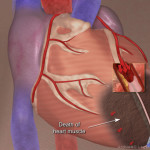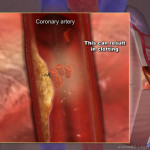The estimated annual incidence of acute myocardial infarction in the United States is 600,000 new cases and 320,000 recurrent attacks. The diagnosis of Acute Myocardial Infarction is made on the basis of a high clinical suspicion based on the history and physical examination findings in addition to changes in cardiac biomarkers and EKG changes. Treatment then focuses on limiting the injury to cardiac tissue. Reperfusion therapy using thrombolytic agents or percutaneous coronary intervention (PCI) should be initiated as early as possible. Oxygen therapy, nitrates, analgesics, aspirin, platelet P2Y12 receptor blockers (Clopidogrel, Prasugrel, and Ticagrelor) antithrombotics, beta-blockers, and angiotensin-converting enzyme (ACE) inhibitors are the cornerstone medications in the initial treatment of Acute Myocardial Infarction. 
Chest pain leading to myocardial infarction is the leading cause of litigation against family physicians. More malpractice dollars are awarded for missed myocardial infarctions than for any other single diagnosis. The typical claim involves allegations of misdiagnosis or mismanagement of tests. Legal professionals, when reviewing cases involving chest pain should pay close attention to documentation pertaining to: 1) evaluation of risk factors, 2) location, duration and radiation of the pain, 3) associated symptoms including shortness of breath, diaphoresis, or light-headedness, 4) precipitating and relieving factors associated with the symptoms, 5) failure to compare present EKG’s with prior EKG’s, and 6) failure to document an explanation for an “abnormal” EKG report that has been generated automatically by the EKG unit used when the EKG itself is clearly a benign tracing (John Davenport, 2000). Treatment is another area that needs to be assessed by the legal professional. The following will be dealt with in more detail later but areas of treatment that need to be reviewed include did the patient receive an aspirin upon arrival to the Emergency Department, followed by, were appropriate thrombolytic agents utilized in a timely manner, what was the time for “arrival to intervention”, and were beta blockers or nitrates ordered. The Joint Commission has developed Core Measures for the treatment of Acute Myocardial Infarctions. In reviewing cases involving an Acute Myocardial Infarction one should assess if these Core Measures were addressed.
Joint Commission Core Measures for Acute Myocardial Infarction
| CORE MEASURE/SAFETY GOAL | IMPACT ON PATIENT OUTCOMES |
| PTCA within 90 minutes | 20% mortality reduction compared with thrombolytics |
| Fibrinolytic Therapy Received Within 30 Minutes of Hospital Arrival
|
18% mortality reduction compared with no treatment |
| Beta-blockers prescribed at discharge | 18% mortality reduction |
| Aspirin on arrival and prescribed at discharge | 25% reduction in stroke, myocardial infarction, or death |
| ACE inhibitors if EF <40% | 20% mortality reduction |
| Smoking cessation | 40% mortality reduction |
| Statin prescribed at discharge | 16% mortality reduction and 25% reduction in recurrent myocardial infarction |
(Andrew L. Masica, Richter, MS, MFA, ELS, Convery, MD, MMM, CPE, & Haydar, MD, MBA, 2009)
When a patient presents with chest pain it is important to get a complete history that includes risk factors for heart disease. Review of the medical record in these cases should include assessing if a complete history was obtained and taken into account when determining evaluation and treatment. Risk factors that lead to atherosclerosis and plaque formation include:
- Advanced age is considered the most significant risk factor for Coronary Artery Disease. Patient over the age of 45 have an eight times greater risk of Acute Myocardial Infarction and less than 10% of patient who have an Acute Myocardial Infarction are under the age of 45. Also risk of death after an Acute Myocardial Infarction is higher in older patients.
- Cigarette smoking has a risk that is directly proportional to the number of cigarettes smoked per day. Secondhand exposure to smoke is also associated with increased cardiovascular risk.
- Elevated cholesterol levels significantly increase the risk of Acute Myocardial Infarction. In addition HDL cholesterol levels less than 40 mg/dl are a risk factor for atherosclerosis.

- Hypertension (high blood pressure) increases ones’ cardiovascular risk. The risk of cardiovascular death doubles with each 20/10 mm Hg increase in blood pressure.
- Diabetes Mellitus.
- Family history of ischemic heart disease in a first-degree relative.
- Male gender.
There are activities that evidence suggest can trigger an Acute Myocardial Infarction. These trigger events include excessive alcohol intake, excessive physical activity, HIV infection, emotional stress, NSAID use, and the use of illicit drugs such as cocaine and amphetamines. Review of the record in a case involving an Acute Myocardial Infarction should also include an assessment regarding whether these issues were noted in the medical record.
Foundation for the diagnosis of Acute Myocardial Infarction are based on an accurate history and EKG changes. Cardiac biomarker elevation occurs hours after an infarction and normal values should not delay treatment in patients with chest pain suggestive of an Acute Myocardial Infarction.
Once a patient presents with the classic symptoms of Acute Myocardial Infarction, medical facilities should have a system in place that collects important data and history from the patient while performing initial diagnostic testing. Rapid establishment of the diagnosis of Acute Myocardial Infarction is critical because treatment options are time dependent.
Part 2 of this Series will address the types of Acute Myocardial Infarction and treatment.
Leave a Comment